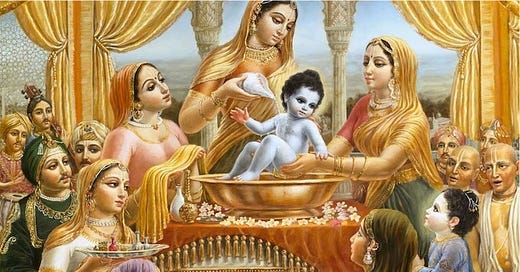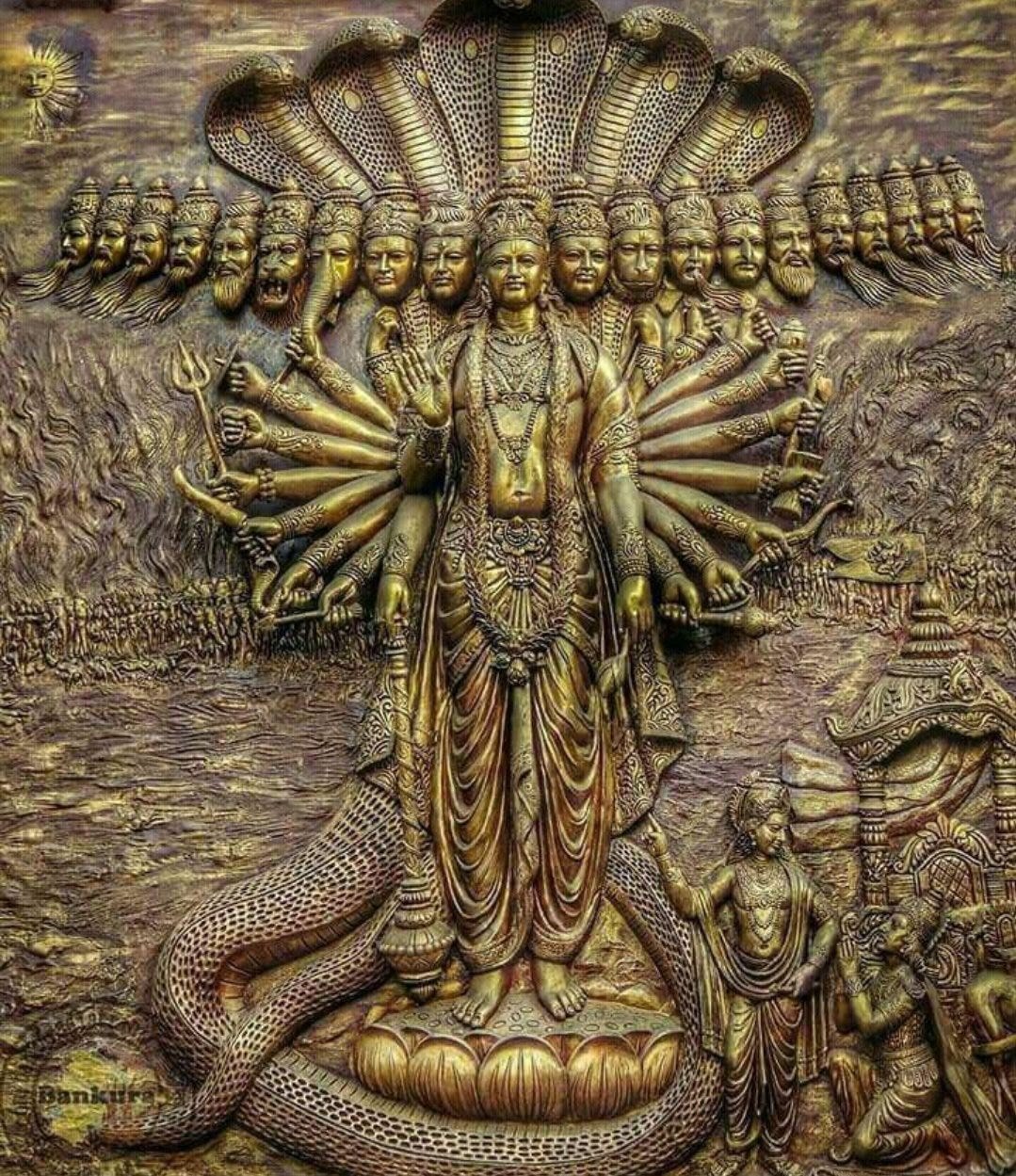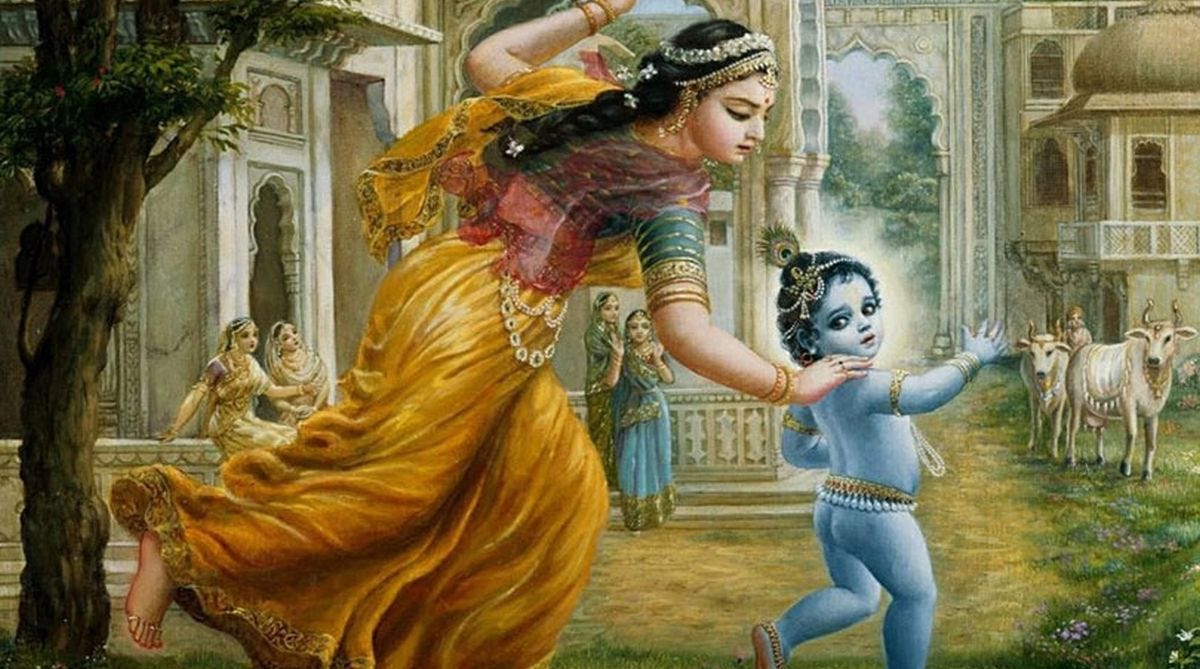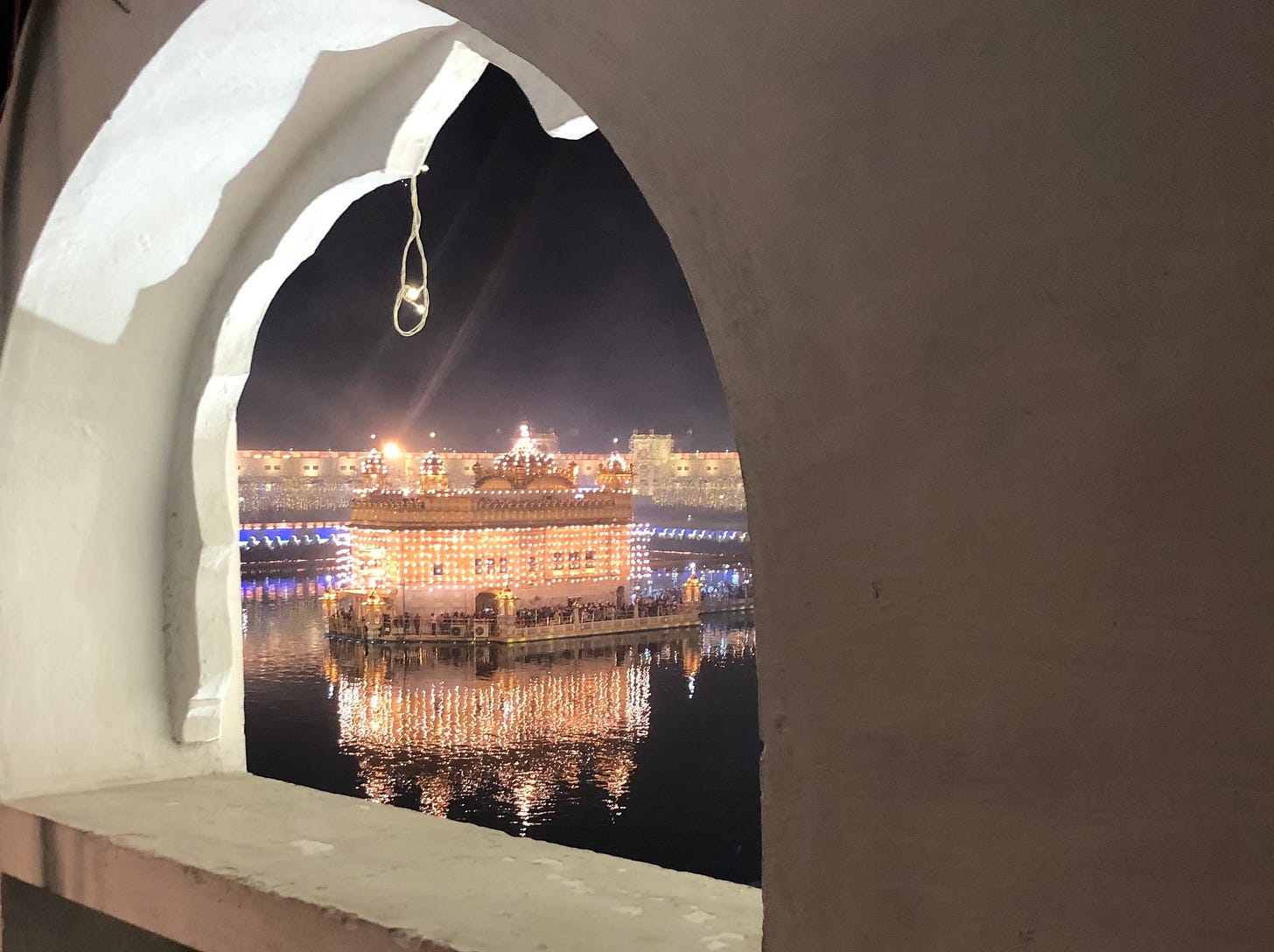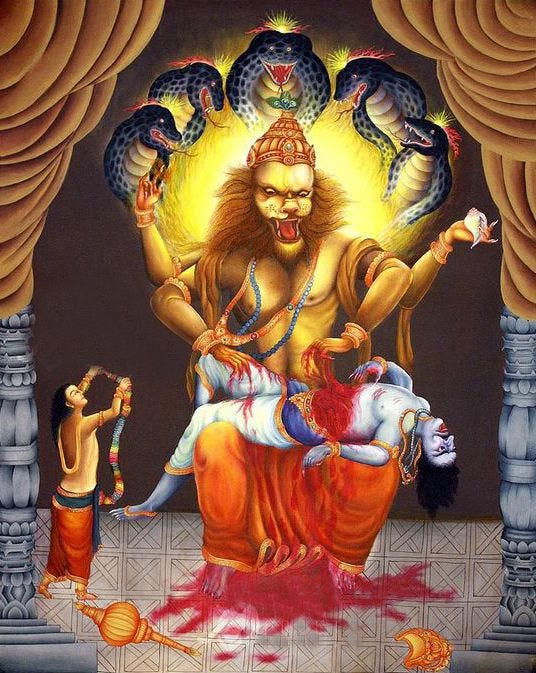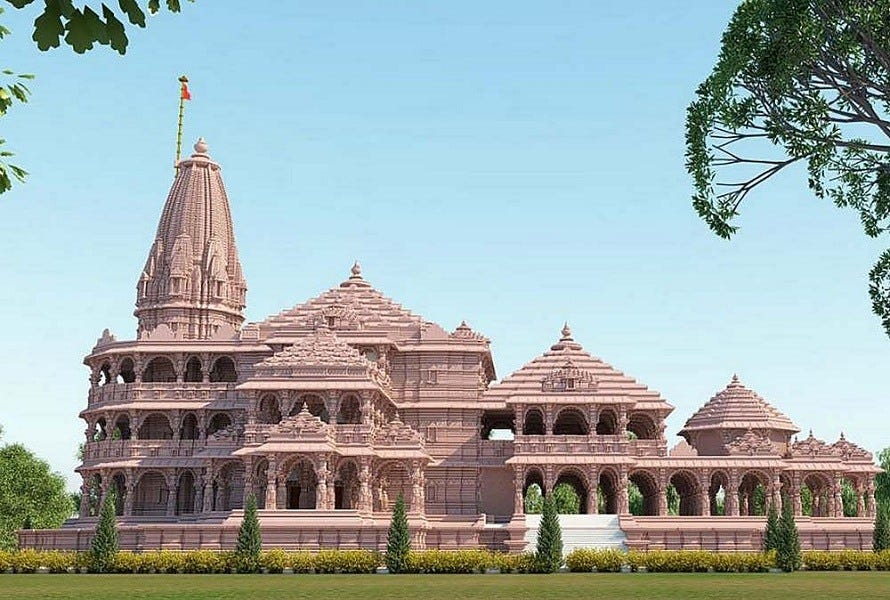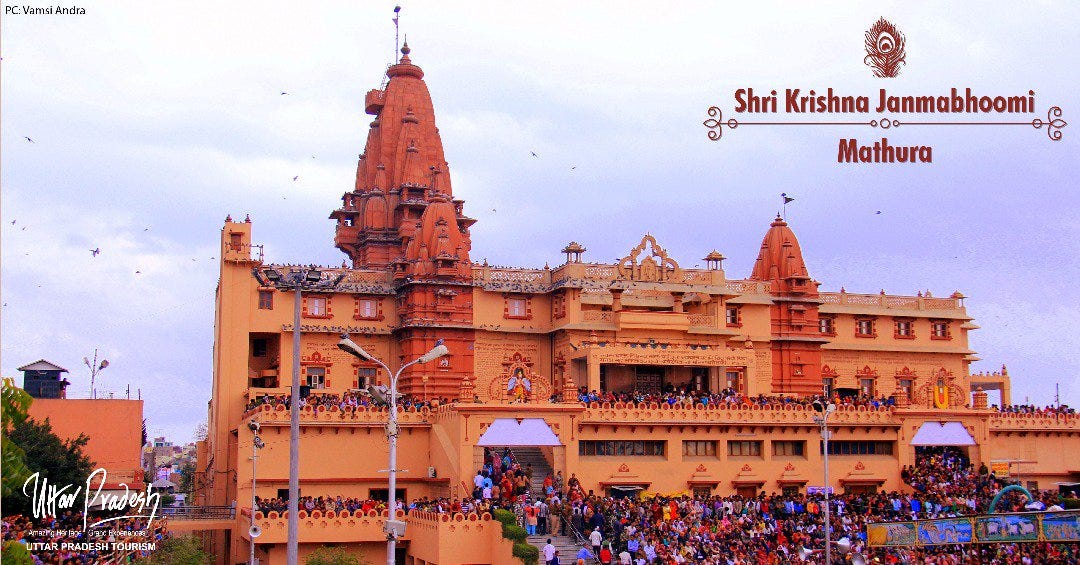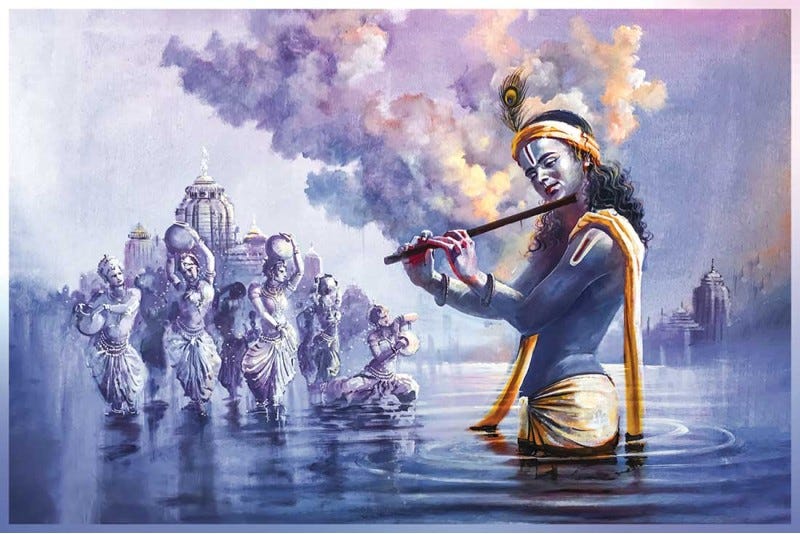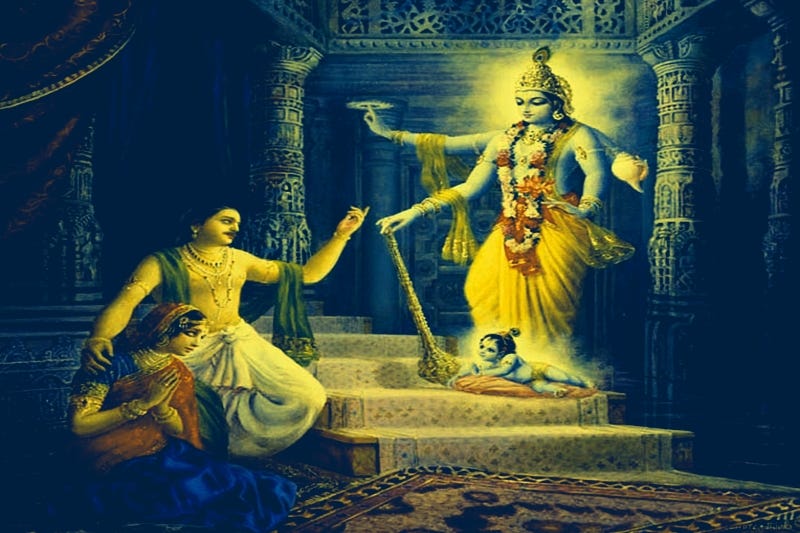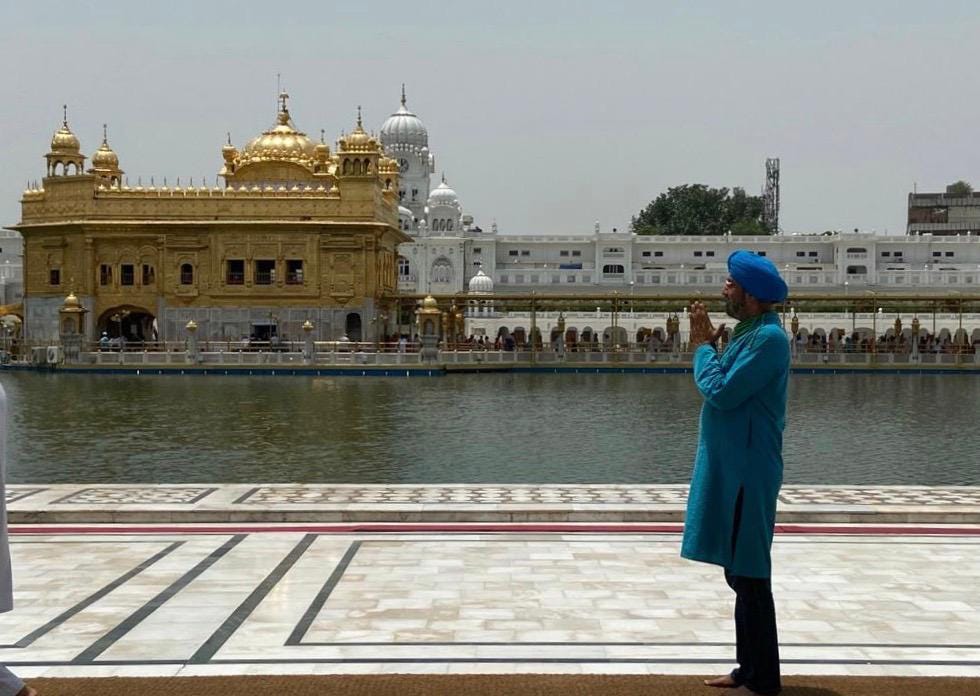Janmashtami Greetings: Lord Krishna in 'Gurbani' of Sri Guru Arjan Dev ji
Janmashtami Greetings: Lord Krishna as Vishnu Avatar in 'Gurbani' of Guru Arjan Dev ji.
Celebrating ‘Janamashtami’: Exploring Guru Arjan Dev Ji's Verses
As we approach the revered occasion of "Janamashtami," commemorating the birth of Lord Krishna, our warmest wishes extend to everyone. This significant day takes on added spiritual depth for those who seek inspiration from the enlightening verses penned by Guru Arjan Dev Ji, the Fifth Nanak, found in Ang 1082 of the Sri Guru Granth Sahib. We take this opportunity to repost our piece from the same auspicious occasion last year, as a humble effort to highlight the underlying harmony in our holy scriptures.
Far from being mere spiritual signposts, these verses deeply reflect the core ethos of “Janamashtami”. They offer intricate perspectives on Lord Krishna and other manifestations of Lord Vishnu, bridging the gap between different forms of devotion and understanding. In these compelling lines, Guru Arjan Dev Ji unearths a nuanced understanding of divine complexity, enriching our Dharmic heritage and directing us toward a more intimate union with the all-encompassing Akal Purakh.
Unveiling the Spiritual Richness of Ang 1082
Ang 1082 serves as more than just a numerical marker; it encapsulates a rich tapestry of spiritual, philosophical, and metaphysical understandings masterfully woven by Guru Arjan Dev Ji. This “shabad” operates as a fascinating crucible where spiritual teachings from different walks of life meld into a harmonious whole. It invites both the devout Sikh and the seeker rooted in Sanatan Dharma or Hinduism (Vaishnavism) to engage in a mutual quest for the Divine, seen through the unique prisms of their respective faiths. As we set forth on this sacred journey, our objective extends beyond a mere scholastic analysis. We make a humble endeavour to delve into the spiritual richness, unearthing the hidden gems of wisdom that Guru Arjan Dev Ji has laid out for the benefit of humanity.
Structure, Composition and Thematic Division
Composed in Raga Maru, this priceless “shabad” consists of 21 stanzas, or ‘pauris’. Each stanza is made up of three verses that adhere to the strict AAB rhyme scheme, resulting in a total of 63 lines, apart from the opening one. The “shabad” is intuitively divided into three interconnected yet independent sections, each containing seven ‘pauris’. Remarkably, the first six ‘pauris’ in each of these sections seem to focus on the avatars of Lord Vishnu, delving into the physical realms associated with Krishna. The seventh ‘pauri’ of each section, however, subtly shifts the focus towards contemplating the formless, all-knowing Akal Purakh. This gracefully symmetrical pattern continues through the "shabad," ultimately culminating in its 63rd line, where Guru Sahib offers a profound obeisance to the all-powerful, all-knowing Divine, the Akal Purakh.
The Pivotal Pauris: Holistic Understanding
For a complete grasp and appreciation of this spiritually rich "shabad," it is essential to focus on pauris number 7, 14, and 21—the closing stanzas of each of the three distinct sections. These pivotal ‘pauris’ guide the reader through a transformative spiritual journey, moving seamlessly from the manifest realm to the realm of the unmanifest, from tangible form to the intangible essence. Due to space constraints, this piece offers a detailed translation only for the first seven ‘pauris’. However, we invite inquisitive seekers to explore a footnote link, which we hope to insert very soon, that will guide them to a comprehensive translation and in-depth explanation of the entire “shabad”.
The Resonance of “Maru Raag”
On this sacred journey through the verses, the significance of the musical measure, "ਮਾਰੂ ਮਹਲਾ ੫ ॥" or Maru Raag, cannot be overstated. Traditionally linked to valour, courage, and profound spiritual longing, Maru Raag serves as an essential conduit for the message Guru Arjan Dev Ji wishes to convey. Far from merely being an aesthetic choice, the Raag acts as an emotional and spiritual amplifier, adding layers of intensity to Guru Sahib’s already intricate tapestry of ideas. Its nature—often perceived as aggressive—conveys an inner strength and fearlessness that reinforces the commitment to express universal truths, regardless of societal or religious constraints. Through the cadence and rhythm of Maru Raag, Guru Arjan Dev Ji enhances our understanding and experience of his universal message, inviting us to partake in a fearless articulation of spiritual wisdom.
Transcending Boundaries: A Universal Approach to the Divine
As we stand on the threshold of offering a verse-by-verse exploration of the initial seven 'pauris,' it is imperative to acknowledge Guru Arjan Dev Ji's transcendent invitation to universal communion with the Divine, transcending narrow religious or cultural frameworks. Whether one's spiritual understanding is rooted in the concept of Akal Purakh—the formless, omnipotent deity in Sikhism—or in the diverse yet revered avatars within Vaishnavism, Guru Arjan Dev Ji's teachings act as a harmonising force. They shed light on an enduring truth: while the Divine might reveal itself in varied forms and narratives, its quintessential essence is immutable. As we embark on this modest yet earnest quest, our aim is to tap into a mere sliver of the manifold yet interconnected spiritual wisdoms, illustrating how Guru Arjan Dev Ji ingeniously weaves them into an overarching, unifying cosmic truth.
ਮਾਰੂ ਮਹਲਾ ੫ ॥
Translation: Maaroo, Fifth Mehl. Explanation: This indicates that the hymn is written in the musical measure (Raag) of Maaroo by the Fifth Sikh Guru, Guru Arjan Dev Ji.
1st Pauri
ਅਚੁਤ ਪਾਰਬ੍ਰਹਮ ਪਰਮੇਸੁਰ ਅੰਤਰਜਾਮੀ ॥
Translation: The Supreme Lord God is imperishable, the Transcendent Lord, the Inner-knower, the Searcher of hearts.
Explanation: The verse introduces God as eternal, beyond human comprehension, and aware of the innermost feelings and thoughts of all beings.
ਮਧੁਸੂਦਨ ਦਾਮੋਦਰ ਸੁਆਮੀ ॥
Translation: He is the Slayer of demons, our Supreme Lord and Master. Explanation: This line describes God as a force of justice and righteousness, invoking names that signify His power over evil.
ਰਿਖੀਕੇਸ ਗੋਵਰਧਨ ਧਾਰੀ ਮੁਰਲੀ ਮਨੋਹਰ ਹਰਿ ਰੰਗਾ ॥੧॥
Translation: The Supreme Rishi, the Master of the sensory organs, the uplifter of mountains, the joyful Lord playing His enticing flute. ||1|| Explanation: The verse describes God as an entity that controls sensory faculties, has the power to uplift and support, and brings joy and enticement through divine "music."
2nd Pauri
ਮੋਹਨ ਮਾਧਵ ਕ੍ਰਿਸ੍ਨ ਮੁਰਾਰੇ ॥
Translation: The Enticer of Hearts, the Lord of wealth, Krishna, the Enemy of ego. Explanation: God is described as the one who captivates hearts, oversees material and spiritual riches, and helps in the dissolution of ego.
ਜਗਦੀਸੁਰ ਹਰਿ ਜੀਉ ਅਸੁਰ ਸੰਘਾਰੇ ॥
Translation: The Lord of the Universe, the Dear Lord, the Destroyer of demons. Explanation: God is portrayed as omnipotent, a dear companion to the devout, and the force that vanquishes evil.
ਜਗਜੀਵਨ ਅਬਿਨਾਸੀ ਠਾਕੁਰ ਘਟ ਘਟ ਵਾਸੀ ਹੈ ਸੰਗਾ ॥੨॥
Translation: The Life of the World, our eternal and ever-stable Lord and Master dwells within each and every heart, and is always with us. ||2|| Explanation: God is omnipresent and eternal, existing within each being and always accompanying them.
3rd Pauri
ਧਰਣੀਧਰ ਈਸ ਨਰਸਿੰਘ ਨਾਰਾਇਣ ॥
Translation: The Support of the Earth, the man-lion, the Supreme Lord God.
Explanation: In this line, Guru Arjan Dev Ji speaks of the Divine as the "Support of the Earth," indicating God's fundamental role in sustaining the world. The term "man-lion" refers to Narasimha, an avatar of Lord Vishnu in Hindu mythology, who emerged to restore cosmic balance. By including this, Guru Sahib indicates that God can take multiple forms to uphold righteousness and balance in the universe.
ਦਾੜਾ ਅਗ੍ਰੇ ਪ੍ਰਿਥਮਿ ਧਰਾਇਣ ॥
Translation: The Protector who tears apart demons with His teeth, the Upholder of the earth.
Explanation: Guru Arjan Dev Ji elaborates on the Divine's role as a Protector in this line. The description "who tears apart demons with His teeth" conjures an image of a fierce defender who eradicates evil. This portrayal serves to reassure believers of God's omnipotent capacity to vanquish negativity and maintain equilibrium.
ਬਾਵਨ ਰੂਪੁ ਕੀਆ ਤੁਧੁ ਕਰਤੇ ਸਭ ਹੀ ਸੇਤੀ ਹੈ ਚੰਗਾ ॥੩॥
Translation: O Creator, You assumed the form of the pygmy to humble the demons; You are the Lord God of all.
Explanation The third line reiterates the Divine's adaptability and omnipresence. Here, Guru Arjan Dev Ji discusses God's form as a "pygmy," referring to another avatar, Vamana, who humbled the demons. This line emphasizes that despite the various forms the Divine can assume, the essence remains the same—being the Supreme Lord God of all.
4th Pauri
ਸ੍ਰੀ ਰਾਮਚੰਦ ਜਿਸੁ ਰੂਪੁ ਨ ਰੇਖਿਆ ॥
Translation: You are the Great Raam Chand, who has no form or feature. Explanation: This line describes the formless nature of the Divine, invoking the name of Raam Chand to signify that God transcends form and features.
ਬਨਵਾਲੀ ਚਕ੍ਰਪਾਣਿ ਦਰਸਿ ਅਨੂਪਿਆ ॥
Translation: Adorned with flowers, holding the chakra in Your hand, Your form is incomparably beautiful. Explanation: While the previous line emphasized the formlessness of God, this one presents an image of divine beauty, signifying the paradox that God can be both formless and full of unimaginable beauty.
ਸਹਸ ਨੇਤ੍ਰ ਮੂਰਤਿ ਹੈ ਸਹਸਾ ਇਕੁ ਦਾਤਾ ਸਭ ਹੈ ਮੰਗਾ ॥੪॥
Translation: You have thousands of eyes, and thousands of forms. You alone are the Giver, and all are beggars of You. Explanation: This line underscores the omnipresence and omnipotence of God. Having 'thousands of eyes' symbolizes God's omniscience, and being the 'one Giver' emphasizes His role as the ultimate provider.
5th Pauri
ਭਗਤਿ ਵਛਲੁ ਅਨਾਥਹ ਨਾਥੇ ॥
Translation: You are the Lover of Your devotees, the Master of the masterless. Explanation: God's benevolent nature is highlighted here, as He is shown to be loving towards His devotees and a guide for those without guidance.
ਗੋਪੀ ਨਾਥੁ ਸਗਲ ਹੈ ਸਾਥੇ ॥
Translation: The Lord and Master of the milk-maids, You are the companion of all. Explanation: This line introduces another dimension of God, that of being a companion to everyone, regardless of their status or role in society, embodying omnipresence.
ਬਾਸੁਦੇਵ ਨਿਰੰਜਨ ਦਾਤੇ ਬਰਨਿ ਨ ਸਾਕਉ ਗੁਣ ਅੰਗਾ ॥੫॥
Translation: O Lord, Immaculate Great Giver, I cannot describe even an iota of Your Glorious Virtues. Explanation: This final verse acknowledges the futility of trying to encapsulate God's greatness in words. The qualities are so infinite that human language falls short in describing them.
These verses from Guru Arjan Dev Ji carry layers of meaning, encapsulating a myriad of divine attributes from formlessness to incomparable beauty, from being the ultimate provider to the guide of the lost.
6th Pauri
ਮੁਕੰਦ ਮਨੋਹਰ ਲਖਮੀ ਨਾਰਾਇਣ ॥
Translation: Liberator, Enticing Lord, Lord of Lakshmi, Supreme Lord God. Explanation: The line praises the Supreme Being by various names and attributes. "Mukand" refers to the liberator, "Manohar" to an entity that captivates the mind, and "Lakshmi Narayan" signifies the Supreme God associated with prosperity. This offers a holistic vision of God, encapsulating the power to liberate, allure minds, and embody prosperity.
ਦ੍ਰੋਪਤੀ ਲਜਾ ਨਿਵਾਰਿ ਉਧਾਰਣ ॥
Translation: Savior of Dropadi's honor.
Explanation:This line refers to the Divine as the savior of Draupadi's honor, a key incident from the Mahabharata where God intervened to protect her. It illustrates God's role as a protector and upholder of righteousness.
ਕਮਲਾਕੰਤ ਕਰਹਿ ਕੰਤੂਹਲ ਅਨਦ ਬਿਨੋਦੀ ਨਿਹਸੰਗਾ ॥੬॥
Translation: Lord of Maya, miracle-worker, absorbed in delightful play, unattached.
Explanation: Here, the Guru describes the Divine as the "Lord of Maya" who performs miracles and is involved in the joyful play of creation, yet remains unattached. This captures the paradoxical nature of God as both immanent in the world and yet transcendent.

7th Pauri
ਅਮੋਘ ਦਰਸਨ ਆਜੂਨੀ ਸੰਭਉ ॥
Translation: The Blessed Vision of His Darshan is fruitful and rewarding; He is not born, He is self-existent.
Explanation: This line highlights the spiritually enriching experience of the Divine's Darshan (sight or vision), describing it as 'Amogh' or infallible. The verse also points to the Divine's timeless nature—never born, self-existent—aligning with core Sikh principles about God's eternal being.
ਅਕਾਲ ਮੂਰਤਿ ਜਿਸੁ ਕਦੇ ਨਾਹੀ ਖਉ ॥
Translation: His form is undying; it is never destroyed.
Explanation: The verse refers to the 'Akaal Murat,' or timeless form of God, emphasizing its undying nature. It suggests that the Divine is beyond the cycle of birth and death, an eternal entity that never perishes, reiterating the eternal nature of God in Sikh philosophy.
ਅਬਿਨਾਸੀ ਅਬਿਗਤ ਅਗੋਚਰ ਸਭੁ ਕਿਛੁ ਤੁਝ ਹੀ ਹੈ ਲਗਾ ॥੭॥
English Translation: O imperishable, eternal, unfathomable Lord, everything is attached to You.
Explanation: The line encapsulates the essence of God as being imperishable, eternal, and beyond human comprehension ('Agocar'). The Guru emphasizes that everything in the universe is connected to this eternal Divine, reinforcing the all-pervading nature of God.
These verses, taken together, paint a rich tapestry of the Divine's characteristics—self-existent, eternal, and unfathomable—while expressing the deep connection that all beings share with this Ultimate Reality.
21st Pauri
ਤੇਰੀ ਗਤਿ ਮਿਤਿ ਤੂਹੈ ਜਾਣਹਿ ॥
Translation: You alone know Your state and extent.
Explanation: In this verse, Guru Arjan Dev Ji emphasizes the incomprehensible nature of the Divine. "Gati" refers to the state, and "Miti" refers to the extent or measure. Guru Ji acknowledges that God is the only one who fully understands its own nature, indicating the limitations of human understanding when it comes to comprehending the Infinite.
ਤੂ ਆਪੇ ਕਥਹਿ ਤੈ ਆਪਿ ਵਖਾਣਹਿ ॥
Translation: You Yourself speak, and You Yourself describe it.
Explanation: Building upon the previous line, Guru Ji suggests that God is both the speaker and the subject. The Divine explains its own nature to those willing to listen and understand. This self-revelatory nature of God is unfathomable for mortals, emphasizing the notion that God is both the discourse and the object of that discourse.
ਨਾਨਕ ਦਾਸੁ ਦਾਸਨ ਕੋ ਕਰੀਅਹੁ ਹਰਿ ਭਾਵੈ ਦਾਸਾ ਰਾਖੁ ਸੰਗਾ ॥੨੧॥੨॥੧੧॥
Translation: Please make Nanak the slave of Your slaves, O Lord; as it pleases Your Will, please keep him with Your slaves. ||21||2||11||
Explanation: In a profound expression of humility, Guru Arjan Dev Ji prays to be made a servant of the servants of God. By asking to be a "Das" (servant) of the "Dasa" (servants), Guru Ji embodies the quintessential spirit of selflessness and devotion. The Guru seeks to align himself with those who are already devoted to the Divine, emphasizing the significance of spiritual community or Sangat.
These lines from Guru Arjan Dev Ji serve as a gentle reminder of the vastness and immeasurability of the Divine and express a deep longing to be in the company of the truly devoted. The Guru teaches us that the path of humility, devotion, and collective harmony is the way to get closer to God.
Multiple Pathways to the Divine: A Unified Exploration of Guru Arjan Dev Ji's Spiritual Wisdom
Having delved into just a fragment of Guru Arjan Dev Ji's spiritually enriching verses, it's evident that they transcend the role of a mere conduit between various religious philosophies. Instead, they amplify the idea that there are multiple routes to comprehending the same ultimate reality. These deeply resonant verses extend invaluable insights not just to followers of Sikhism and Vaishnavism, but also to seekers in the broader scope of Sanatan Dharma, and indeed, anyone eager to deepen their spiritual acumen.
The Sanatan Dharma: Journey Through Divine Manifestations
From the vantage point of Sanatan Dharma or Vaishnavism, Guru Arjan Dev Ji’s verses resound with narratives deeply anchored in ancient scriptures. He navigates us through these diverse philosophies, validating each avatar's distinct role in maintaining cosmic equilibrium. In this journey, he resonates with their fundamental tenets while preserving the distinctiveness of each path to the Divine.
The Sikh Perspective: The Many and the One in Akal Purakh
For a devout Sikh, these verses serve to deepen the understanding of Akal Purakh—the formless, timeless Divine. Particularly illuminated through the key 7th, 14th, and concluding 21st 'pauris,' these teachings underscore the Sikh belief in a singular, formless entity that not only permeates but also transcends the tangible world. Guru Sahib clarifies that Akal Purakh embodies the unitary Divine consciousness, animating a plethora of forms while executing the divine will in various ways.
Unity in Spiritual Diversity: The Universal Essence of the Divine
What is exceptionally compelling about these verses is their capability to harmonise apparently divergent viewpoints. Regardless of whether one engages with the Divine through the frameworks of Sanatan Dharma, Vaishnavism, or Sikhism, Guru Arjan Dev Ji highlights the universal essence that is foundational to these spiritual pathways. This unifying capacity renders the verses a paragon of spiritual inclusivity, fortifying the faith of seekers across diverse spiritual landscapes.
Unifying Spiritual and Earthly Paths: Our Concluding ‘Janamashtami’ Reflection
In conclusion, as we revel in the auspiciousness of ‘Janmashtami’, may Lord Krishna's tales of valour serve as a robust anchor in our earthly pursuits. At the same time, let Guru Arjan Dev Ji's enlightening verses light our way on the spiritual path. These teachings are not at odds but remarkably complementary, offering a holistic guide for anyone aspiring to be a ‘Karmayogi’, seamlessly integrating worldly responsibilities with spiritual commitments.
REQUEST: If you enjoyed this article from 'The KBS Chronicle', we encourage you to share it with others who might also find it valuable.
Click the link below to access easy sharing options for Twitter, Facebook, and Email. The same link also generates a web-link that can be shared via messaging apps like WhatsApp, Telegram, or Signal, in both individual and group settings.
Thank you for your support.

